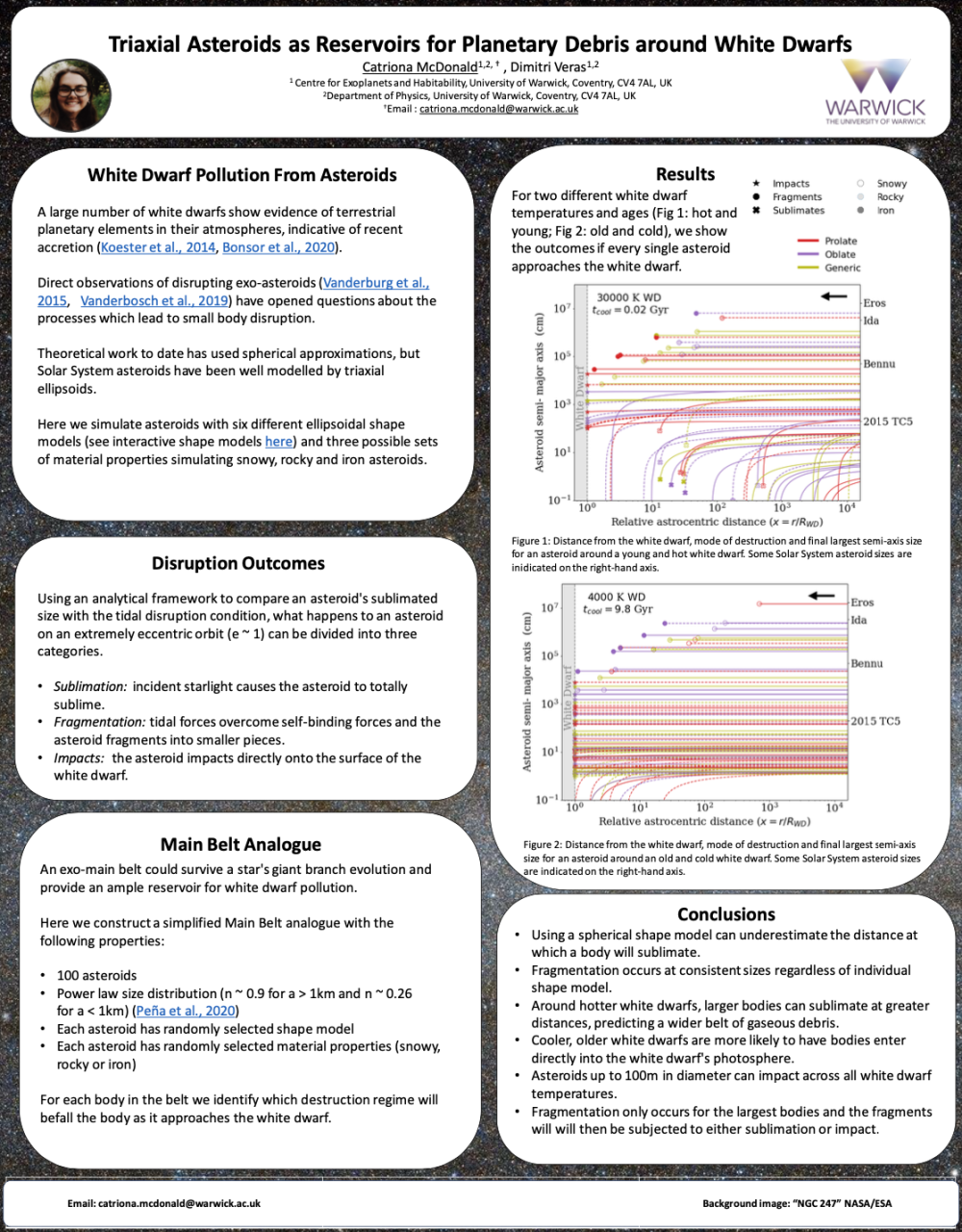Research News & Highlights
UKI Discs Meeting 2024 to be hosted at the University of Warwick
Our discs group recently started the UK & Ireland (UKI) Discs community, where we aim to bring together the disc communities across the UK & Ireland for those working on astrophysical discs on various scales, from circumplanetary to galactic discs. We are excited to announce the first UKI Discs Meeting will be hosted at the University of Warwick from the 9th - 11th of September 2024 and will focus on protoplanetary discs and debris discs (including white dwarf discs). To register and find out more, follow the link hereLink opens in a new window.
The abstract submission deadline for talks/posters is the 12th of May 2024.

Planetesimals drifting through dusty and gaseous white dwarf debris discs: Types I, II and III-like migration
Dimitri Veras, Shigeru Ida, Evgeni Grishin, Scott J. Kenyon, Benjamin C. Bromley
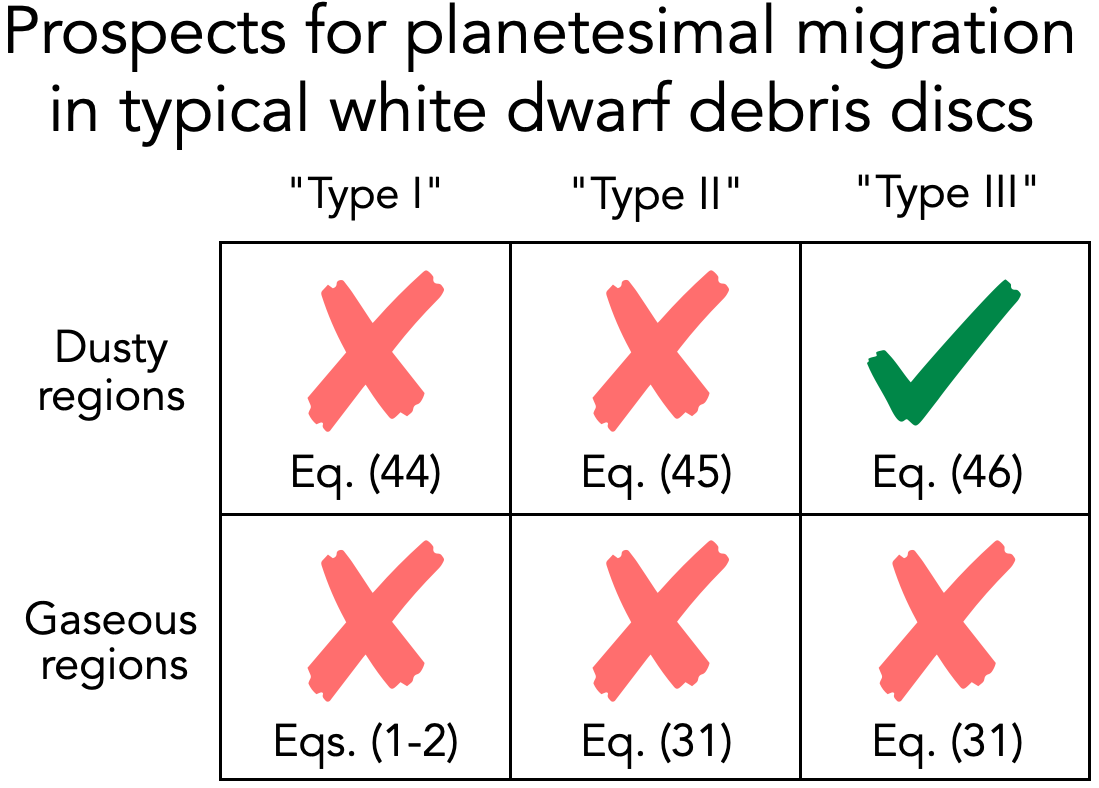
The suite of over 60 known planetary debris discs which orbit white dwarfs, along with detections of multiple minor planets in these systems, motivate investigations about the migration properties of planetesimals embedded within the discs. Here, we determine whether any of the migration regimes which are common in (pre-)main-sequence protoplanetary discs, debris discs and ring systems could be active and important in white dwarf discs. We investigate both dust-dominated and gas-dominated regions, and quantitatively demonstrate that Type I and Type II migration, as well as their particulate disc analogues, are too slow to be relevant in white dwarf discs. However, we find that the analogue of Type III migration for particulate discs may be rapid in the dusty regions of asteroid- or moon-generated (>1018 kg) white dwarf discs, where a planetesimal exterior to its Roche radius may migrate across the entire disc within its lifetime. This result holds over a wide range of disc boundaries, both within and exterior to 1R⊙, and such that the probability of migration occurring increases with higher disc masses.
Orbit decay of 2-100 au planetary remnants around white dwarfs with no gravitational assistance from planets
Dimitri Veras, Yusuf Birader, Uwais Zaman
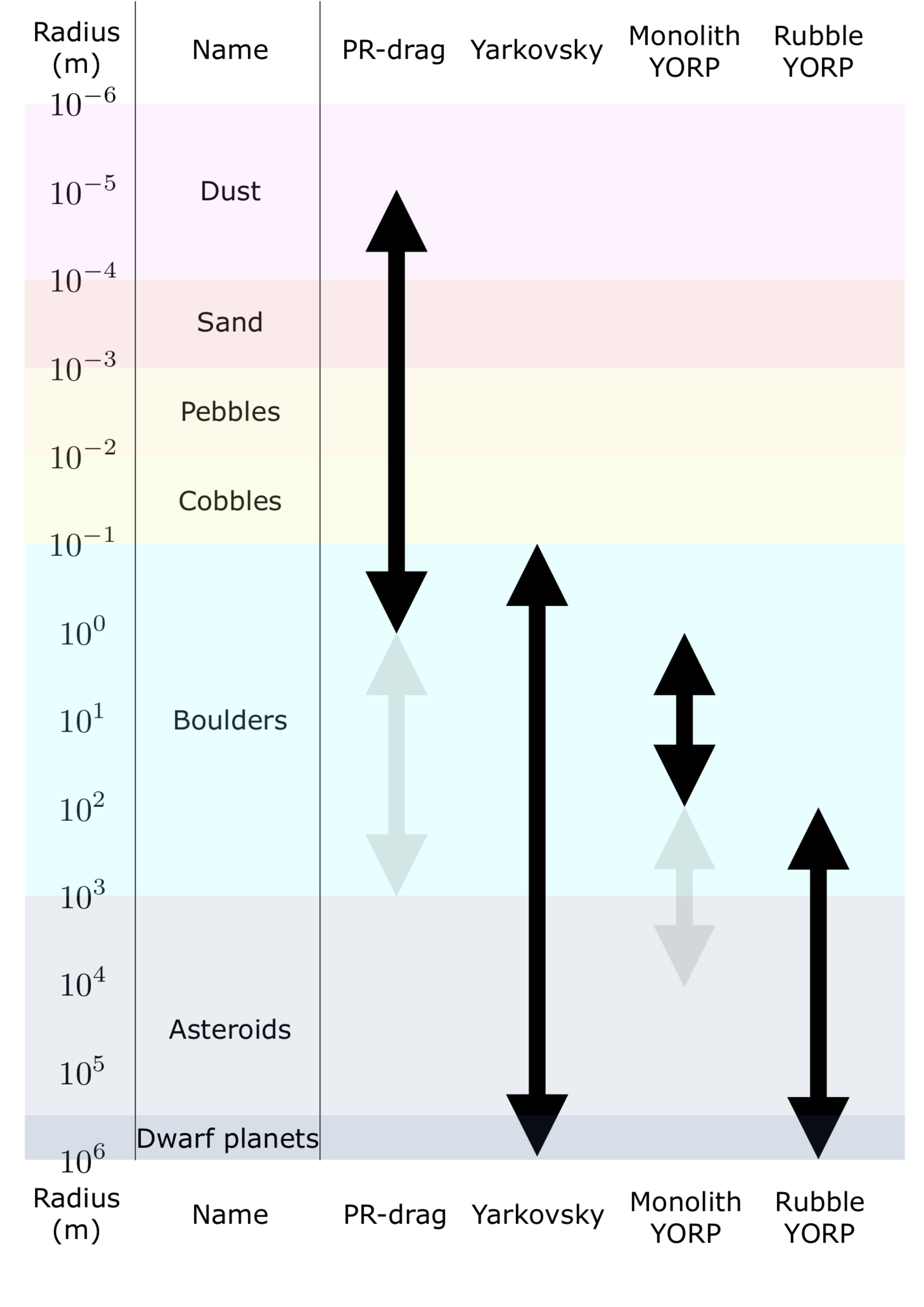
Debris discs orbiting white dwarfs are the primary conduit though which planetary remnants accrete onto the photosphere. A widely-held assumption is that these discs are formed by the destruction of asteroids flung towards the white dwarf by a terrestrial or giant planet. However, these planets could have been previously been engulfed by the star or escaped the system, leaving behind asteroids, boulders, cobbles, pebbles, sand and dust. These remaining small bodies could then persist throughout the host star's evolution into a white dwarf at ~2-100 au scales, and then be radiatively dragged towards the white dwarf to create the disc without the help of a planet. Here we identify the parameter space and cooling ages for which this one metal-pollution mechanism is feasible by, for the first time, coupling Poynting-Robertson drag, the Yarkovsky effect and the YORP effect solely from rapidly dimming white dwarf radiation (see figure). We find that this no-planet pollution scenario is efficient for remnant 10^-5-10^-4 m dust up to about 80 au, 10-4-10-3 m sand up to about 25 au and 10^-3-10^-2 m small pebbles up to about 8 au, and perhaps 10^-1-10^0 m small boulders up to tens of au. Further, young white dwarf radiation can spin up large strength-less boulders with radii 10^2-10^3 m to destruction, breaking them down into smaller fragments which then can be dragged towards the white dwarf. Our work hence introduces a planet-less metal-pollution mechanism that may be active in some fraction of white dwarf planetary systems..
Velocity-imaging the rapidly precessing planetary disc around the white dwarf HE 1349-2305 using Doppler tomography
Christopher J. Manser, Erik Dennihy, Boris T. Gänsicke, John H. Debes, Nicola P. Gentile Fusillo, J. J. Hermes, Mark Hollands, Paula Izquierdo, B. C. Kaiser, T. R. Marsh, Joshua S. Reding, Pablo Rodríguez-Gil, Dimitri Veras, David J. Wilson
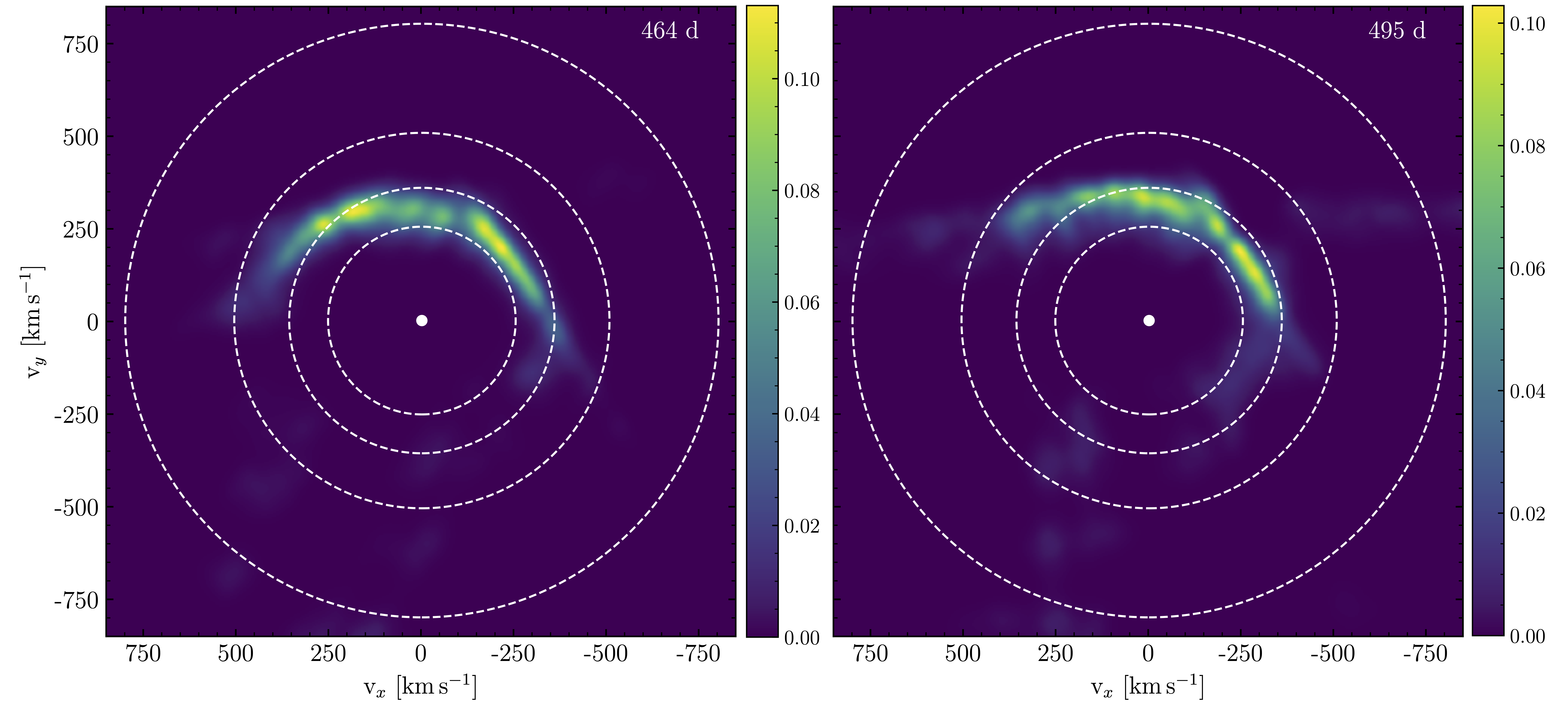
The presence of planetary material in white dwarf atmospheres, thought to be accreted from a dusty debris disc produced via the tidal disruption of a planetesimal, is common. Approximately five per cent of these discs host a co-orbital gaseous component detectable via emission from atomic transitions - usually the 8600 Angstrom CaII triplet. These emission profiles can be highly variable in both morphology and strength. Furthermore, the morphological variations in a few systems have been shown to be periodic, likely produced by an apsidally precessing asymmetric disc. Of the known gaseous debris discs, that around HE1349-2305 has the most rapidly evolving emission line morphology, and we present updated spectroscopy of the CaII triplet of this system. The additional observations show that the emission line morphologies vary periodically and consistently, and we constrain the period to two aliases of 459±3d and 502±3d. We produce images of the CaII triplet emission from the disc in velocity space using Doppler tomography - only the second such imaging of a white dwarf debris disc. We suggest that the asymmetric nature of these velocity images is generated by gas moving on eccentric orbits with radially-dependent excitation conditions via photo-ionisation from the white dwarf. We also obtained short-cadence (~ 4 min) spectroscopy to search for variability on the time-scale of the disc's orbital period (~ hours) due to the presence of a planetesimal, and rule out variability at a level of ~ 1.4 per cent.
White dwarf planetary debris dependence on physical structure distributions within asteroid belts
Catriona H. McDonald, Dimitri Veras
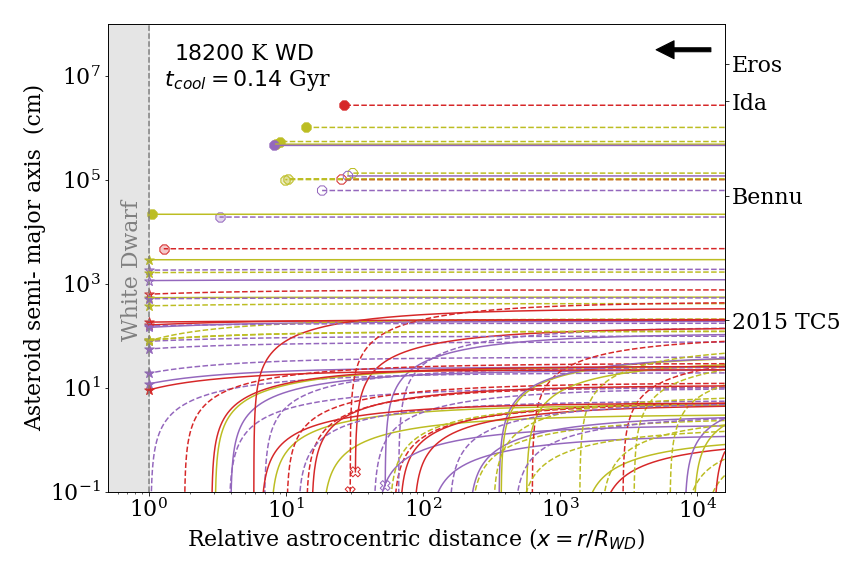
White dwarfs which exhibit transit signatures of planetary debris and accreted planetary material provide exceptional opportunities to probe the material composition and dynamical structure of planetary systems. Although previous theoretical work investigating the role of minor body disruption around white dwarfs has focussed on spherical bodies, Solar System asteroids can be more accurately modelled as triaxial ellipsoids. Here we present an analytical framework to identify the type of disruption (tidal fragmentation, total sublimation or direct impact) experienced by triaxial asteroids approaching white dwarfs on extremely eccentric (e ~ 1) orbits. This framework is then used to identify the outcomes for simplified Main belt analogues of 100 bodies across five different white dwarf temperatures. We also present an empirical relationship between cooling age and effective temperature for both DA and DB white dwarfs to identify the age of the white dwarfs considered here. We find that using a purely spherical shape model can underestimate the physical size and radial distance at which an asteroid is subjected to complete sublimation, and these differences increase with greater elongation of the body. Contrastingly, fragmentation always occurs in the largest semi-axis of a body and so can be modelled by a sphere of that radius. Both fragmentation and sublimation are greatly affected by the body's material composition, and hence by the composition of their progenitor asteroid belts. The white dwarf temperature, and hence cooling age, can affect the expected debris distribution: higher temperatures sublimate large elongated asteroids, and cooler temperatures accommodate more direct impacts.
A review: planetary systems around white dwarfs
Dimitri Veras
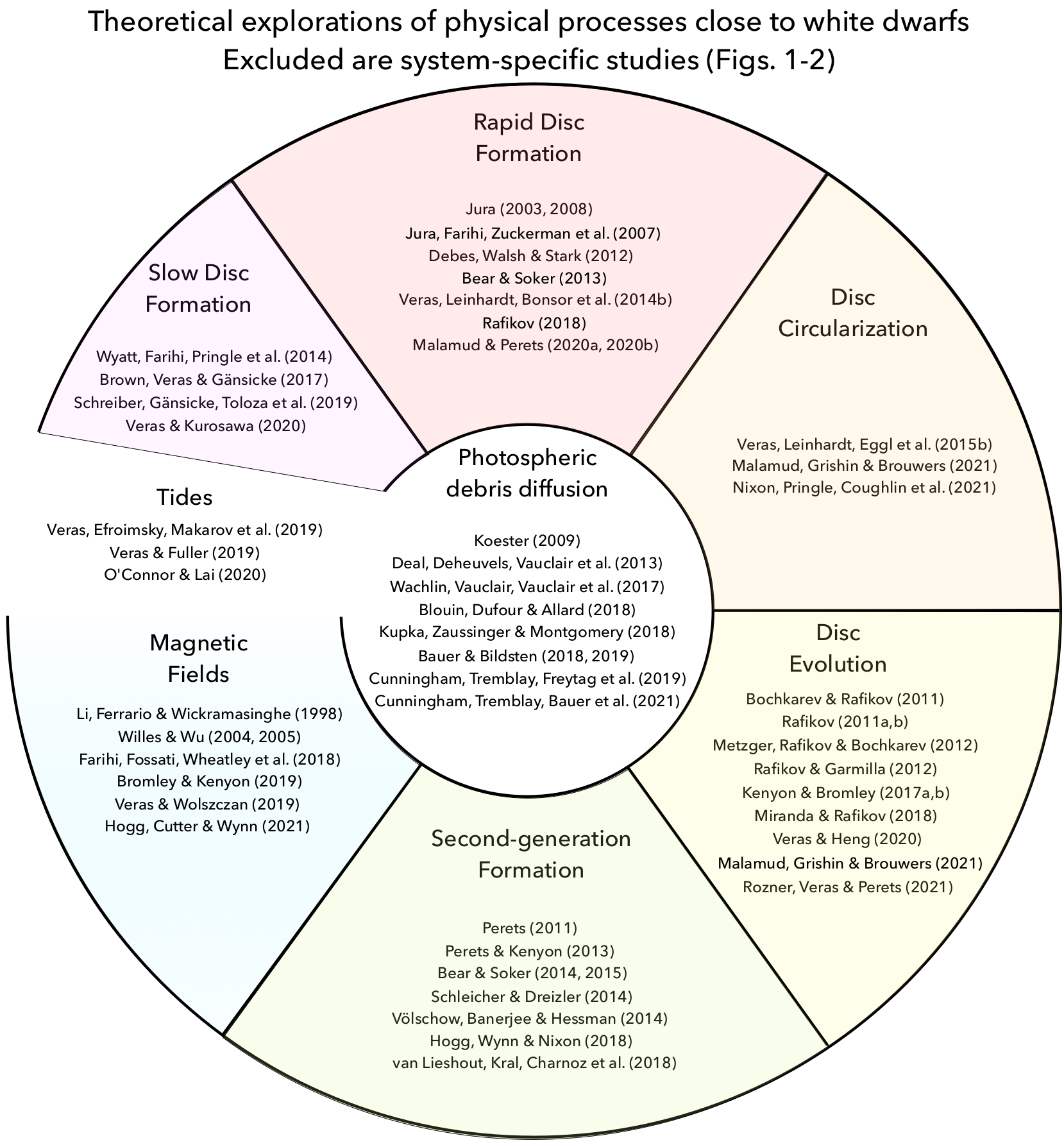
White dwarf planetary science is a rapidly growing field of research featuring a diverse set of observations and theoretical explorations. Giant planets, minor planets, and debris discs have all been detected orbiting white dwarfs. The innards of broken-up minor planets are measured on an element-by-element basis, providing a unique probe of exoplanetary chemistry. Numerical simulations and analytical investigations trace the violent physical and dynamical history of these systems from au-scale distances to the immediate vicinity of the white dwarf, where minor planets are broken down into dust and gas and are accreted onto the white dwarf photosphere. Current and upcoming ground-based and space-based instruments are likely to further accelerate the pace of discoveries.
The post-main-sequence fate of the HR 8799 planetary system
Dimitri Veras, Sasha Hinkley
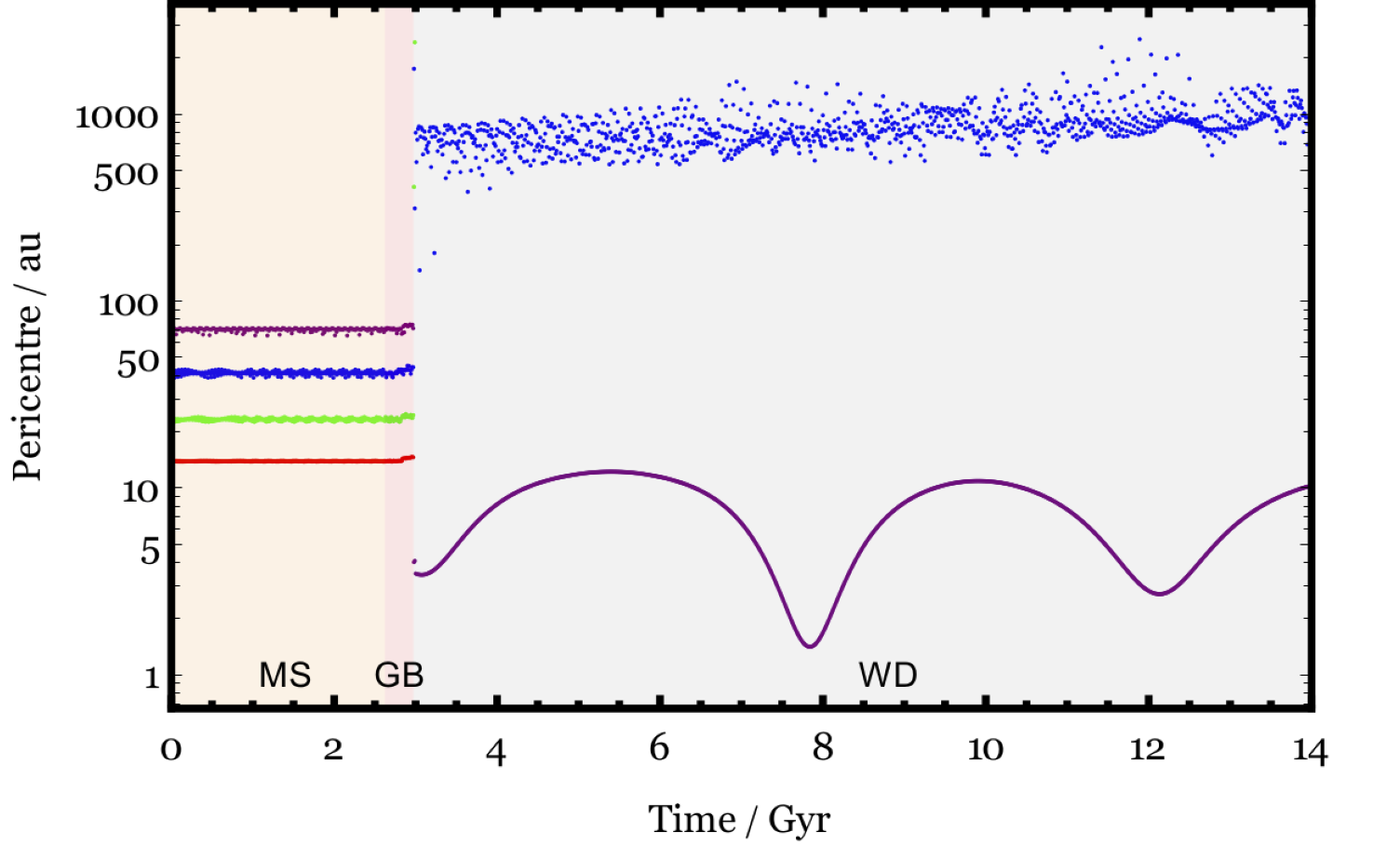
The noteworthy four-planet HR 8799 system teeters on the brink of gravitational instability and contains an A-type host star which is characteristic of the progenitors of the majority of known white dwarf planetary system hosts. Gozdziewski and Migaszewski (2020) have demonstrated that the system can retain all four planets for at least 1 Gyr along the main sequence if the planets evolve within an externally unperturbed 8:4:2:1 mean motion resonance configuration. Here we propagate forward their most stable fit beyond the main sequence, and incorporate external effects from Galactic tides and stellar flybys. We find that (i) giant branch mass loss always breaks the resonance, and usually triggers the ejection of two of the planets, (ii) stellar flybys and Galactic tides rarely break the resonance during the main-sequence and giant branch phases, but play a crucial role in determining the final planetary configurations around the eventual white dwarf host star, and (iii) the meanderings of the surviving planets vary significantly, occupying regions from under 1 au to thousands of au. The ubiquitous survival of at least one planet and the presence of the debris discs in the system should allow for dynamical pathways for the white dwarf to be metal-polluted.
KITP Online Conference: White Dwarfs from Physics to Astrophysics
Christopher Manser -- Gaseous planetary discs around white dwarfs
Five Years After HL Tau
Sahl Rowther -- Are Gravitationally Unstable Protoplanetary Discs Rare?
The work covered in this talk is described in Rowther et al. 2020.
Rebecca Nealon -- Spirals, Shadows and Precession in HD 100453 Part 2
Part 1 can be viewed here.
Dimitri Veras - Constraining Planet Formation Around 6-8 Solar Mass Stars
The work covered in this talk is described in Veras et al. 2020.
Exoplanet Demographics
Christopher Manser -- Doppler Imaging of a Second Planetary Debris Disc Around a White Dwarf
Talk begins at 4:16:02.
Dimitri Veras -- Full-lifetime Simulations of Planetary Systems
Talk begins at 2:00:00.
Catriona McDonald -- Triaxial Asteroids as Reservoirs for Planetary Debris around White Dwarfs
Here, we present an analytical framework incorporating tidal, self-gravitational and internal strength forces to triaxial ellipsoids approaching a white dwarf on extremely eccentric (e ~ 1) orbits. Such extreme orbits could be produced by dynamic interactions with planets in the white dwarf system. The subsequent disruption of the asteroids is split into three distinct regimes: tidal fragmentation, sublimation, and direct impact. This framework is extended to cover a simplified Main Belt analogue of 100 planetesimals with an observational size distribution and randomly chosen shape model and material, for a range of white dwarf temperatures. We find that using a spherical shape model consistently underestimates where sublimation occurs and overestimates fragmentation distance. The small spatial scales of white dwarf planetary systems can cause these discrepancies to have a large effect on predicted debris distributions. Our results allow us to place constraints on the expected planetary debris from asteroids at different white dwarf cooling ages and motivates future studies to include more accurate shape models

